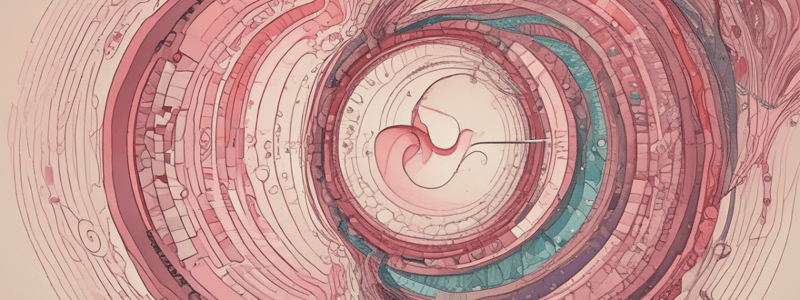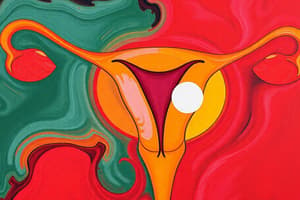Podcast
Questions and Answers
What is the primary function of progesterone during the secretory stage of the menstrual cycle?
What is the primary function of progesterone during the secretory stage of the menstrual cycle?
- To inhibit FSH secretion
- To stimulate the hypothalamus
- To trigger ovulation
- To thicken the endometrium and cause fluid secretion (correct)
What event marks the start of the secretory stage of the menstrual cycle?
What event marks the start of the secretory stage of the menstrual cycle?
- Ovulation (correct)
- A decrease in oestrogen levels
- The start of menses
- A surge in FSH secretion
What is the primary function of FSH during the menstrual cycle?
What is the primary function of FSH during the menstrual cycle?
- To stimulate ovulation
- To stimulate oestrogen production by developing follicles (correct)
- To inhibit GnRH secretion
- To thicken the endometrium
What is the primary source of progesterone during the secretory stage of the menstrual cycle?
What is the primary source of progesterone during the secretory stage of the menstrual cycle?
What is the result of the positive feedback loop involving oestrogen and FSH during the menstrual cycle?
What is the result of the positive feedback loop involving oestrogen and FSH during the menstrual cycle?
What is the primary function of GnRH during the menstrual cycle?
What is the primary function of GnRH during the menstrual cycle?
What is the main difference between grey matter and white matter in the central nervous system?
What is the main difference between grey matter and white matter in the central nervous system?
What happens to the endometrium if fertilization does not occur?
What happens to the endometrium if fertilization does not occur?
What is the correct arrangement of grey and white matter in the brain?
What is the correct arrangement of grey and white matter in the brain?
What is the function of human chorionic gonadotropin (HCG) in early pregnancy?
What is the function of human chorionic gonadotropin (HCG) in early pregnancy?
What is the period of development when different organs begin to form?
What is the period of development when different organs begin to form?
What is the purpose of capacitation in the uterus?
What is the purpose of capacitation in the uterus?
When do the four chambers of the heart form?
When do the four chambers of the heart form?
What is the resulting cell when the pronuclei of the sperm and egg fuse?
What is the resulting cell when the pronuclei of the sperm and egg fuse?
What is the term for a developing human from week 8 to birth?
What is the term for a developing human from week 8 to birth?
What is the purpose of the cortical reaction during fertilization?
What is the purpose of the cortical reaction during fertilization?
When does the brain begin developing?
When does the brain begin developing?
What occurs during cleavage?
What occurs during cleavage?
When do the kidneys begin developing?
When do the kidneys begin developing?
What is the function of the trophoblasts during implantation?
What is the function of the trophoblasts during implantation?
What is the term for a developing human from fertilization to week 7?
What is the term for a developing human from fertilization to week 7?
What is the primary function of the developing placenta and umbilical cord?
What is the primary function of the developing placenta and umbilical cord?
What occurs during gastrulation?
What occurs during gastrulation?
What is the result of neurulation?
What is the result of neurulation?
Study Notes
The Menstrual Cycle
- The menstrual cycle consists of two stages: proliferative and secretory.
- Menses (4-5 days) marks the removal of the superficial layer of the endometrium, and Day 1 of the cycle is the first full day of bleeding.
- The proliferative stage is characterized by a sustained increase in oestrogen, which stimulates GnRH secretion by the hypothalamus.
- GnRH triggers LH and FSH secretion from the anterior pituitary, leading to increased oestrogen production by developing follicles.
- A large increase in LH triggers ovulation (around day 14), which marks the start of the secretory stage.
The Menstrual Cycle (Secretory Stage)
- During the secretory stage, the corpus luteum secretes progesterone and small amounts of oestrogen.
- Progesterone thickens the endometrium and causes fluid secretion (nutrients for the embryo).
- Progesterone and oestrogen inhibit the hypothalamus and anterior pituitary, leading to a decline in LH and FSH secretion after ovulation.
- If fertilization occurs, the endometrium becomes fully developed, and human chorionic gonadotropin (HCG) production by the trophoblasts during implantation of the embryo maintains the corpus luteum.
- If fertilization does not occur, the endometrium is sloughed, and the corpus luteum degenerates, reducing progesterone and increasing FSH.
Fertilization and Preimplantation Embryo Development
- Fertilization occurs when sperm capacitation in the uterus (enzymes) stabilizes the acrosomal head and strengthens tail motility.
- The secondary oocyte is released into the uterine duct/fallopian tube.
- The blastocyst is formed, consisting of an inner cell mass and trophoblasts.
Fertilization to Birth
- Fertilization (Day 0) occurs when the pronuclei of sperm and egg fuse.
- Two mechanisms prevent polyspermy: a fast block (Na+) and a slow block (Ca2+) release.
- The zygote is formed when the pronuclei fuse, and the zona pellucida is shed.
Cleavage
- Cleavage occurs from Day 1 to 6, with repeated mitotic divisions as the embryo migrates down the oviduct to the uterus.
- The zona pellucida degenerates, and the underlying trophoblast takes over.
Implantation
- Implantation occurs from Day 7 to 10, with the production of human chorionic gonadotropin (HCG) by the trophoblasts.
- Two types of trophoblasts contribute to the development of the placenta.
- The developing placenta and umbilical cord form a filtration barrier.
Gastrulation
- Gastrulation occurs on Day 12, with the formation of the embryonic disc, primitive streak, and central axis.
- The three germ cell layers are formed: ectoderm, mesoderm, and endoderm.
- Ectoderm develops into skin and the nervous system, mesoderm develops into organs, muscle, and bone, and endoderm develops into the digestive system.
Neurulation
- Neurulation occurs on Day 18, with the folding of the neural tube, which determines the position of grey and white matter in the central nervous system.
- The spinal cord and brain develop with grey matter outside and white matter inside.
Organogenesis
- Organogenesis begins around 3 to 8 weeks and continues until birth, with the development of different organs.
- The brain begins developing in week 3, the heart begins developing in week 3, and the kidneys begin developing in week 9.
- From fertilization to week 7, a developing human is referred to as an embryo, and from week 8 to birth, it is called a fetus.
Studying That Suits You
Use AI to generate personalized quizzes and flashcards to suit your learning preferences.





